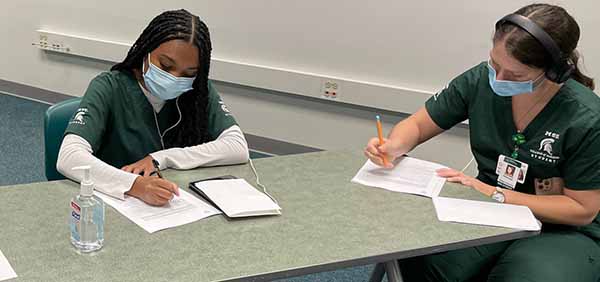News
Exercise pumps "voices" into students' heads

Imagine trying to complete a crossword puzzle and being told “you never get anything done.”
Or trying to talk to your psychotherapist only to hear “you’re not good enough.”
These aren’t voices coming from your friend or therapist, rather, it’s a voice inside your head casting doubt and causing frustration in the simplest of tasks. It’s an issue many patients with mental health issues grapple with daily and something BSN students with the Michigan State University College of Nursing recently got a small taste of during a simulation.
"I work with students on psychosis and thought disorders,” said Dr. Katherine Marshall, an assistant professor and organizer of the experience. “It is very difficult for the average person to understand when internal stimulation or hearing voices is like.”
The simulation, which has now been run for two semesters, requires students to wear headphones and listen to audio of a variety of voices and phrases at different volumes, gradually getting louder and softer, while completing tasks, such as word searches, number finds, applying for jobs, finding directions on their phones, and explaining some basic conditions to a patient. The simulation demonstrates what someone with what Marshall calls “auditory hallucinations” goes through in their daily lives.
“It’s interesting observing the students as they face these challenges – you begin to see changes in their own affect and how they speak.” said Emily McIntire, the simulation lab coordinator. “Their conversations are less upbeat, and even the tone of their voice changes.”
Students themselves noted a challenge when facing these “simple tasks.” During a reflection period, students expressed how over-stimulating the exercise was. One student noted that one voice made it hard to work and noted their frustration.
“There were specific voices that kept coming back and as soon as they would, I would think ‘not this again,’” one student wrote.
Another student said they had a better understanding of what it means when someone says they “hear voices.”
“During the simulation experience, it gave more insight to what goes on,” the student wrote. “All in all, I felt like the experience was worth it. It helps to empathize with the patients who are experiencing this.”
And that is exactly what Marshall and McIntire are hoping students will take away from the experience.
“You can be more effective when providing care if you understand and empathize with what a patient is experiencing,” Marshall said.
